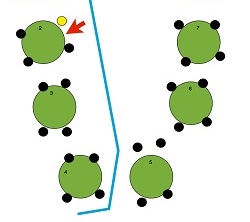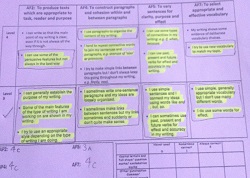
Adam teaches Key Stage 3 to Key Stage 5 English at Cramlington Learning Village – a large comprehensive in Northumberland.
Whatever a person’s profession, self-reflection is an important part of making sure you’re doing the best with your work-hours. Teachers, of course, are developing the minds of the future, so it’s important that they can really examine the pros and cons of their work ethic. Adam Lewis, English teacher at Cramlington Learning Village, Northumberland, very much recommends recording yourself in the classroom.

We’ve all been observed whilst teaching, whether it’s by mentors, mentees, colleagues, SMT or even the dreaded OFSTED. We’re given feedback and we try and implement changes to improve our teaching. However, it is often difficult to remember which part of the lesson the observer is referring to, or which student in particular is being criticised for not being focused enough.
Videoing yourself teaching can change all that. Either by setting up a camera at the back of the classroom, asking a colleague to film it for you or investing in more professional hardware designed for schools, you can transform the way you approach professional development.
On 30th January, we featured an article by Adam Lewis on how he aims to teach like a champion. In this follow up piece, he discusses how he has altered his teaching methods further in order to fit in with this ideal.

I have continued to employ the methods put forward in my last blog post. These adjustments are now starting to become embedded into my practice, so that I am actively aware that I am using them consistently and this seems to be having a positive effect on my students. I will now not continue until every hand is straight up and, as a result, all my classes are quicker to be ready to listen with their hands straight up in the air a lot quicker than previously in the year.
Similarly, if one student is not following the procedure, I use positive group correction ("thank you to the whole of the left side of their room with their hands straight up") and, if not successful, move on to anonymous individual correction ("I'm just waiting on one student on the right side to put their pen down and put their hand straight up"). This has resulted in some students admonishing the student who the class is waiting on, which is negating the positive effect of the anonymous individual correction, but on the other hand, it does seem to be creating a strong team within the class.
I have adjusted my technique to include tracking the speaker. These are clear instructions to turn and watch the person who is speaking at the time. Although this is not completely embedded, I am reminding the students who are often the ones not seen tracking to try and do this consistently. When I introduce SLANT into my practice, I hope that this will be even more consistent.
Schoolchildren possess growing, developing minds, ones which can often wander. Therefore, it’s important for teachers to know how to retain their attention. To discuss this further, Innovate my School regular Adam Lewis discusses how to ‘teach like a champion’.

For the following weeks, I am focussing on creating a strong classroom culture by adhering to the techniques advocated by Doug Lemov in his 'Teach Like a Champion' manual for teachers.When I posted on Twitter that I was starting this experiment, Doug kindly tweeted me asking for me to let him know which techniques I was going to focus on first.
Although I have been teaching my current classes for over a term, I still feel that some of them don't have the kind of classroom culture that I expect. Establishing this is vital for any relationships to exist and develop, so this is the first 'section' of the techniques that I will focus on.
Week 1 of my 'Teach Like a Champion' marginal gains experiment and I am concentrating on '100%' and 'Sweat the Details.
Although it may not be possible to keep an eye on every student while you're teaching, by making small changes to your positioning in the classroom as you respond to individual questions or visit different tables, you can have a much wider view of the class which allows you to spot any misbehaviour or 'silent discos', as Adam Lewis puts it.

One of the first bits of advice I received regarding my behaviour management was to set-up my teaching radar.
This made me initially think there was some kind of device which could be set-up in the classroom to, firstly, detect where students were when my back was turned and, secondly, hopefully nuke the ones who were engaging in off-task behaviour.
It was soon explained to me that it was the art of knowing where your students were and what they were up to at all times. But the problem was that there was no device for this; it relied on your skill as a teacher.
When work is marked, it usually only includes a single grade with a sentence of constructive criticism. However, the benefits of using categorised marking ensures that the student is totally clear on where his/her strengths are, where they need to improve, where they lack understanding and any parts of the exam criteria that they have missed.
Using different colours or symbols will also ensure that students take more notice of specific comments as they are given a thorough analysis and a clear and plausible route for improvement. Who knew just one piece of work could hold so much insight?

Ah, the dreaded red pen. Students, parents and SLT often cringe at the sight of the red ink used by a teacher. Maybe because it's a symbol for blood?
I think it's more likely to be linked to the idea that teachers from a previous age would use just a red pen to mark work and would be likely to mark negatively; pointing out mistakes or circling poor work.
However, when a teacher marks their books now, they are usually (or hopefully) better trained into what marking works and what will benefit their students' learning.
Having students identify for themselves where they think they need to improve and then comparing this to their performance on a task will give an accurate insight into which parts of the criteria they do not understand how to satisfy. The teacher can then point this out and explain how it can be achieved. A good method to conduct this is by using 'predictive grids':

Too often, students see the grade that they receive and do not take enough notice into the written feedback that is given during marking. Dylan Wiliam's suggestion of not giving the grade to the students works but I've been wanting the students to engage with the success criteria when it comes to their exams and they really are incredibly motivated by seeing the grades, or even a number.
Something suggested by a colleague, which I've started to implement with exam classes, is 'predictive grids'. These are success criteria grids (usually using the exam board language as much as possible) which the students highlight according to what they think they achieved in the piece of work. This can either be done directly after the piece of work is finished or the lesson after which is what I usually prefer to do. When the work is marked, the teacher can then see where specifically the students are not achieving, but also see if the students know if they are not achieving in that particular area.
In his latest blog post, English teacher Adam Lewis describes an innovative yet stunningly simple method students can use to ensure they are improving in the actual areas where they need to improve. The so-called 'scaffolds' that Adam writes about are the tools a student may or may not need to answer a question and can 'bet' on, such as working with a partner, but there's a catch - each scaffold is 'priced' accordingly to how objectively useful it is and, if chosen, will cost the student marks at the end of their answer. We think it's an ingenious method for students to help them discover their own individual strengths and weaknesses, and we encourage you to read Adam's post in full below.

I'm afraid I do like a flutter but, as a teacher, I can't afford to spend more than a few pennies (literally) each week. I decided to introduce this idea to the classroom. I've only used this in my Year 12 English Language class but I expect it could be easily applied to most classes and would result in interesting conversations in most contexts.
It allowed my Year 12 class, who have target grades from A-D, to choose the differentiation they required. Each scaffold was given 'a mark'. These scaffolds included being given the mark scheme, getting examiner comments about successful responses and working in a pair. There were about ten different scaffolds available and each scaffold would cost the students marks in their final mark for the question from 2 marks for the least useful scaffold to 20 marks for the most useful.

Over the last few weeks, lots of bloggers have been giving advice to incoming NQTs about how to deal with behaviour in their first year of teaching. Whilst not wanting to compete with this advice, as the advice comes from more experienced teachers, I would like to give my own personal tips to NQTs, as it is only a year since I was in that position myself.
There are a number of things which I wish I'd known last year, which would have made my first year a whole lot easier.

A community-driven platform for showcasing the latest innovations and voices in schools
Pioneer House
North Road
Ellesmere Port
CH65 1AD
United Kingdom